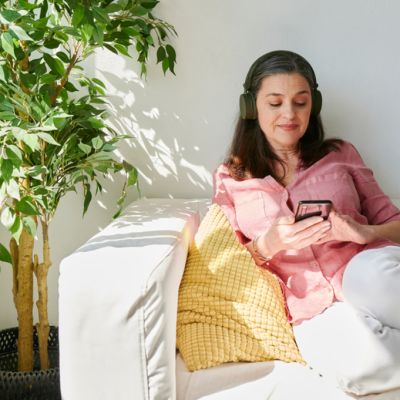Can you train yourself to sleep better around noise and light?

When my husband has friends over at night, I prepare to sleep with hands over ears. Their laughter may be faint, but I know my sleep will be pushed back several hours.
Since I prefer not to use earplugs, I wondered if there are ways to soundproof my room, or even better, to get my body desensitised to noise.
It turns out the answer to both is “yes”, according to sleep experts. The same goes for light, a glimmer of hope for those who struggle to sleep when the curtain lets the street light in at night.
So, how do you soundproof and lightproof your room at bedtime?

Dr. Andrew Bradbeer, a sleep specialist at Sleep Health Group in Victoria, says heavy drapes or curtains are effective at blocking out light and noise. If using block-out blinds or curtains, Rosemary Clancy, a sleep psychologist at Sydney Sleep Centre, recommends setting your alarm to wake you so you can expose your body to the early morning sunlight. Morning sunlight resets your circadian clock – your internal sleep clock – so your brain is ready for sleep when it gets dark.
If you’re keen to do more extensive renovations, sleep experts suggest noise-proofing your room by installing double-glazed windows, switching hollow doors for ones with a solid core, and replacing floorboards with carpet. Acoustic carpet underlay is an additional option if you’re in a multi-storey building, says Dr. Dorothy Bruck, a sleep psychologist from the Sleep Health Foundation in New South Wales.

Smaller room modifications can also do the trick. To prevent sound dribbling in through doorways, Bradbeer suggests lining the base of the door with door snakes. Besides this, “you can put up sound barriers, like a room divider or bamboo divider,” says Bradbeer. “And wallhangings tend to suppress noise as well, things like pictures or rugs hung on walls.”
Besides sound or light proofing your room, how can you train yourself to sleep better around noise and light?
Say the worse case scenario happens, and noise or light continues to seep into your bedroom after renovations. We have good news for you. Sleep can be trained, and here, Clancy and Bruck explain how you can make a start.

First, relax your self-imposed rules about what a perfect sleep environment looks like
Consider whether you might have rigid beliefs about sleep, says Clancy. “As soon as you put a condition on your sleep, like the room needs to be completely dark or quiet for me to sleep or it won’t work, it becomes a self-fulfilling prophecy.” Holding these rigid sleep beliefs creates performance anxiety about sleep, Clancy explains.
Instead, practice saying to yourself, “I don’t need to have it perfectly dark or quiet at night to sleep”. The hope is that over time, as your thoughts and beliefs shift, your wakefulness in response to an imperfect sleep environment dies down.
Think differently about the noise or light
Noise or light keeps us up if we have an emotional response to it, says Clancy. For instance, if your neighbour’s dog often barks at 10 o’clock at night and you’re already irritated by it, each time you hear its bark, your body goes into a heightened state where it feels like it’s in danger. This springs you into wakefulness, and until you can turn off that emotional response, you’ll find it harder to fall asleep.
To train your brain not to produce an emotional response, Bruck suggests reminding yourself the noise or light is neutral, thinking about it in an emotionally flat way. This communicates to the brain that you aren’t in any danger and don’t need to respond to it, so you can go to sleep.
Practice ignoring the noise, with assistance from an added predictable sound

Ignoring a noise involves shifting your attention to something else. To help you do this, Clancy says to introduce white or pink noise at a slightly higher volume than the noise you’re trying to ignore. You’re not trying to completely eradicate the noise, but help your brain turn off recognition of the sound.
How does white or pink noise do this? “Your brain stops noticing data that is unchanging,” Clancy explains. A sporadic sound, like raucous laughter at a party next door, is unpredictable and perks up the brain to pay attention to it. With predictable white or pink noise, your brain turns off the message of threat. “Once that is turned off so you’re no longer frustrated by it, your brain stops taking in information about the sound, even though the sound is still there.”
Clancy says the aim of this is to lead you to realise you have the ability to ignore the sound, even if it is still there, albeit more faintly, among the white or pink noise.
We recommend
We thought you might like
States
Capital Cities
Capital Cities - Rentals
Popular Areas
Allhomes
More










